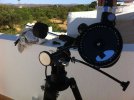
Stargazers will have plenty of opportunities this month as, provided the weather behaves, we should be able to see Mercury, Jupiter, Saturn, Venus AND Mars in the glittering night sky.
As a guide, the brightest stars are equal to zero magnitude, whereas the very brightest objects in the sky (Venus, Jupiter, the moon and the sun) have negative magnitude numbers. You can also use your hand as a slightly crude but surprisingly useful way to estimate angular distances. Obviously everyone has different sized hands, but generally speaking your clenched fist held at arm’s length is roughly equal to 10 degrees of the sky. If you stretch out your thumb and pinky, the distance in between is around 25 degrees. Your middle three fingers held together span around 5 degrees, and the width of your pinky is about 1 degree. It’s inaccurate, but it will help you quickly find objects in the sky.
June 7
If you gaze toward the south-southwest part of the sky on the evening of the 7th, you should be able to see the moon with Mars glowing bright around 3 degrees above it. At the moment it’s 77.9 million miles away and has a magnitude of around -0.4, so it’s pretty bright, but it will slowly fade as it gets further away.
June 10
Around an hour after sunset you should be able to see a full moon and Saturn in the south-southeast part of the sky. Saturn will appear as a very bright star-like object around 5 degrees to the upper right of the moon.
June 19
You should be able to see Mercury in the early morning sky as it passes between the sun and Earth (inferior conjunction).
June 24
If you fancy getting up around an hour-hour and a half before sunrise, you’re in for a real treat. A very slim crescent moon can be found toward the east-northeast horizon, and around 3 degrees to the upper left of it will be Venus. If you’ve got a pair of binoculars handy, about 10 degrees above Venus is the Pleiades star cluster, but the sky needs to still be dark in order to see it.
June 28
If you look to the sky around an hour after sunset, you should see a slither of the moon toward the west-northwest horizon. You’ll then be able to find Jupiter floating around 5 degrees directly above the moon. Towards the end of July, Jupiter will make the transition from being visible in the evening sky to the morning.
Check out this video from space.com as a guide to the sky in June:
Find Jupiter, Saturn, Mars and Venus In June 2014 | Skywatching Video
http://www.iflscience.com/space/there-will-be-5-planets-visible-june-heres-how-see-them
regards fireblade.

